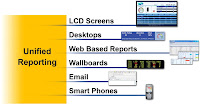
Unified Reporting (UR) provides a snap shot view of the most important KPI's from various data sources.
- Snap Shot View: This is a report that is updated continuously so the information is real time and accurate. You do not want to make a decision based on old information.
- Most important KPI's: These will vary by company and industry. The KPI's should include metric information more than statistics. Metric information shows how well someone or some group is performing. Statistics just show what has been done. For example, average handle time is a statistic while CSat is a metric.
- Data Sources: These are different software applications that are also in operation in the call center. In the call center industry these sources could be any of the following: ACD, WFM, CRM, Ticketing Systems, Customer Satisfaction surveys, or other in house data source. There are many different applications in the call center and this is just a short list.
Unified Reports can take different shapes and sizes depending on how the report is going to be used. Reports can be displayed on LCD screens, LED wallboards, Agent and Team leader desktops, web based reports, configured as email messages or as short flash reports through an SMS message.
Furthermore the unified reporting would change based on the person viewing the report. Agents will see real time information about their performance, team leaders will see reports for the groups they manage and managers will see reports that are more historical than real time and will be for the entire call center.
Unified Reporting is an ideal way of bringing together critical data from the many call center applications. Saving time, being more efficient and reducing the many headaches that come with trying to find critical data are the benefits of unified reporting.



